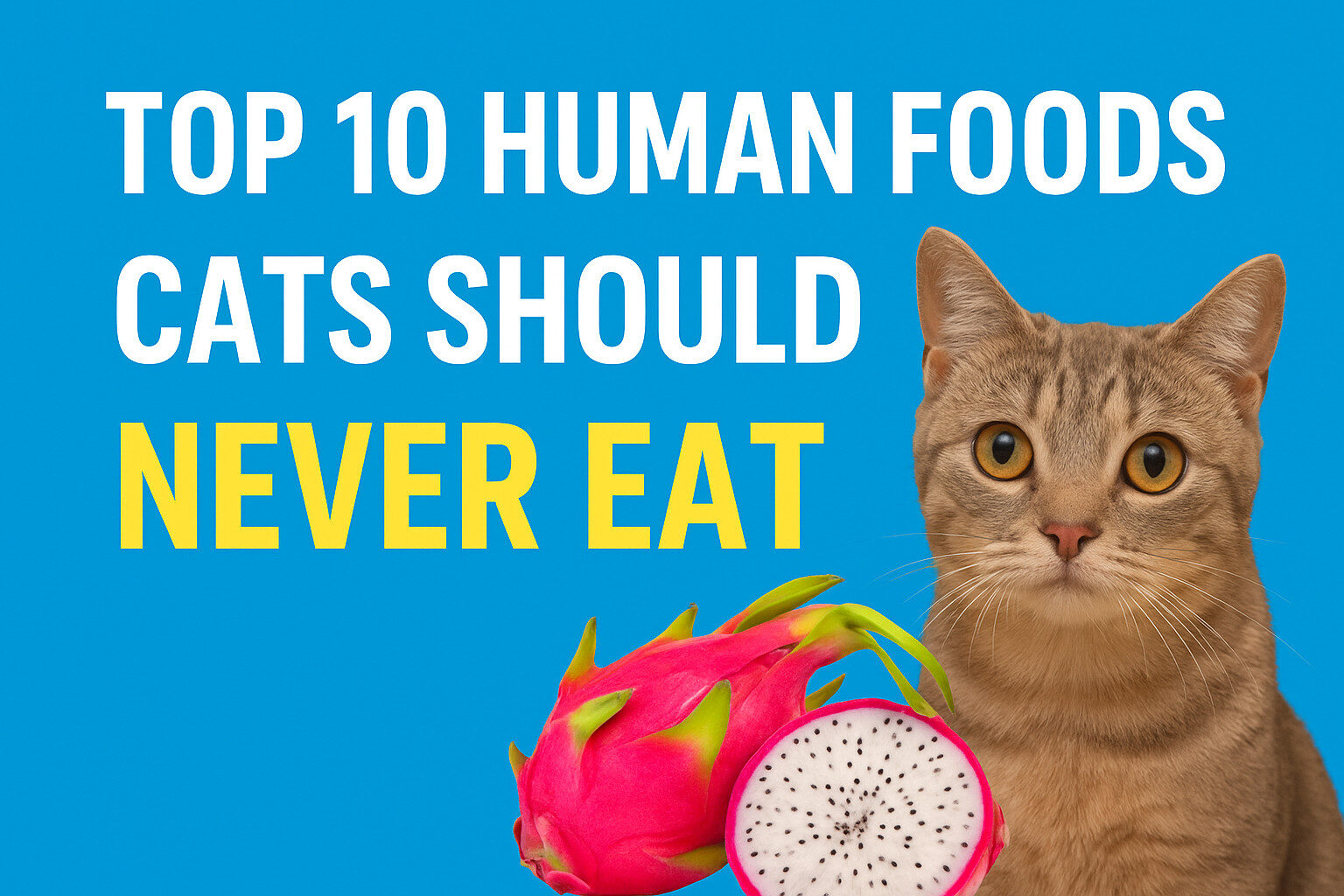This guide covers the top 10 dangerous foods for cats, explaining why they’re bad, the signs of trouble, and crucial tips to prevent mishaps. Bookmark this list – it could save your cat’s life!
1. Chocolate & Caffeine: A Double Dose of Danger
- Why it’s Toxic: Chocolate contains theobromine and caffeine, stimulants cats cannot metabolize effectively. Dark chocolate and baking chocolate are the most potent.
- The Danger: Ingestion can lead to vomiting, diarrhea, rapid breathing, increased heart rate, hyperactivity, tremors, seizures, and even death. The darker the chocolate, the higher the risk.
- Practical Tips:
- Keep all chocolate (candy, baked goods, cocoa powder) securely stored away.
- Never leave coffee, tea, energy drinks, or soda unattended.
- Be vigilant during holidays like Halloween and Easter when chocolate is abundant.
2. Onions, Garlic, Chives & Leeks: The Allium Family Threat
- Why it’s Toxic: These plants (alliums) contain compounds called disulfides and thiosulphates, which damage cats’ red blood cells, leading to hemolytic anemia. Garlic is about 5 times more potent than onion.
- The Danger: Symptoms often appear days later and include weakness, lethargy, pale gums, reduced appetite, orange-tinged urine, and rapid breathing. Even powdered forms in soups, sauces, or baby food are risky.
- Practical Tips:
- Avoid feeding cats any human food seasoned with onion or garlic.
- Check ingredient labels on broths, stocks, and gravies before sharing.
- Securely dispose of onion/garlic peels and scraps – curious cats might nibble.
3. Alcohol: Absolutely Zero Tolerance
- Why it’s Toxic: Cats’ livers cannot process alcohol (ethanol). Even tiny amounts can cause poisoning. Alcohol is also found in raw yeast dough, vanilla extract, and some medications.
- The Danger: Ingestion leads to vomiting, diarrhea, decreased coordination, difficulty breathing, tremors, coma, and can be fatal. Severe drop in blood sugar and body temperature are also risks.
- Practical Tips:
- Never intentionally give your cat alcohol.
- Keep drinks well out of reach, especially during parties.
- Store mouthwash, perfumes, and cleaning products containing alcohol securely.
4. Grapes & Raisins: A Mysterious Kidney Killer
- Why it’s Toxic: The exact toxic compound in grapes and raisins is unknown, but ingestion is strongly linked to acute (sudden) kidney failure in cats.
- The Danger: Vomiting (often within hours), hyperactivity, lethargy, abdominal pain, decreased urination, and kidney failure can occur. The toxic dose varies greatly between individuals, so any amount is risky.
- Practical Tips:
- Never offer grapes or raisins as treats.
- Keep trail mix, cereals, baked goods (like raisin bread or scones), and fruit salads containing them away from cats.
- Be extra careful when children are eating these snacks.
5. Xylitol: The Hidden Sweetener Hazard
- Why it’s Toxic: Xylitol is an artificial sweetener commonly found in sugar-free gum, candy, baked goods, peanut butter, and some medications. It triggers a massive insulin release in cats, leading to dangerously low blood sugar (hypoglycemia), and can also cause liver damage.
- The Danger: Symptoms include vomiting, lethargy, loss of coordination, seizures, and liver failure, which can occur within hours or days.
- Practical Tips:
- Crucially: Check labels on anything sugar-free or labeled “low-sugar,” especially peanut butter!
- Keep gum, mints, and toothpaste containing xylitol out of reach.
- Inform houseguests about this hidden danger.
6. Raw Dough (Yeast): A Rising Risk
- Why it’s Toxic: Uncooked yeast dough continues to rise in a cat’s warm stomach. This produces carbon dioxide gas (causing painful bloating) and ethanol (alcohol) as a byproduct of fermentation.
- The Danger: Severe abdominal distension (bloating), vomiting, disorientation, difficulty breathing (from pressure on the diaphragm), and alcohol poisoning.
- Practical Tips:
- Never let your cat access rising bread dough.
- Cover dough securely and place it well out of reach (like inside a cold oven with a note on the door!).
- Clean up any flour or dough spills immediately.
7. Dairy Products (Milk, Cheese, Ice Cream): Not the Treat You Think
- Why it’s Problematic: While not acutely toxic like some items, most adult cats are lactose intolerant. They lack sufficient lactase enzyme to digest the lactose sugar in milk.
- The Danger: Consumption typically leads to digestive upset: vomiting, diarrhea, and gas. It’s uncomfortable and messy! Some cheeses are also very high in fat and salt.
- Practical Tips:
- Skip the saucer of milk! It’s a myth that it’s good for them.
- Avoid giving cheese, ice cream, yogurt, or cream as regular treats.
- If you want a dairy-like treat, opt for specially formulated “cat milk” available at pet stores (given sparingly). For a healthy diet foundation, explore our guide on [Creating a Balanced Diet for Your Indoor Cat].
8. Canned Tuna (For Humans): A Salty, Addictive Problem
- Why it’s Harmful: While plain, cooked tuna in water occasionally is okay, making it a regular part of their diet is bad. Human tuna lacks essential nutrients cats need (like taurine) and is often packed with salt. It can also contain mercury.
- The Danger: Nutritional deficiencies leading to heart problems (taurine deficiency) or blindness. High sodium levels can cause salt poisoning (excessive thirst, urination, vomiting, tremors). Cats also easily become addicted, refusing healthier food.
- Practical Tips:
- Reserve human tuna for very rare, tiny treats, rinsed under water to remove excess salt.
- Never feed tuna packed in oil or with seasonings.
- Stick to high-quality, nutritionally complete cat food as their primary diet. If you want fish, choose cat food formulated with fish.
9. Fat Trimmings & Cooked Bones: Pancreas Peril & Choking Hazards
- Why it’s Toxic/Harmful:
- Fat Trimmings (Raw or Cooked): Can cause pancreatitis (inflammation of the pancreas), a painful and potentially life-threatening condition.
- Cooked Bones: Easily splinter, causing choking, internal punctures, or life-threatening intestinal blockages. They can also damage teeth.
- The Danger: Pancreatitis symptoms include vomiting, severe abdominal pain, lethargy, and dehydration. Bone fragments can cause choking, bloody stool, constipation, or signs of obstruction (vomiting, loss of appetite).
- Practical Tips:
- Never give your cat cooked bones (chicken, turkey, fish, etc.).
- Discard fatty trimmings securely in a covered bin.
- If offering meat, choose lean, cooked, unseasoned pieces without bones or fat.
10. Raw Eggs & Raw Meat: Bacterial and Biotin Risks
- Why it’s Risky:
- Salmonella/E. coli: Raw eggs and meat carry a high risk of bacterial contamination (Salmonella, E. coli), causing severe food poisoning in cats (and potentially spreading to humans).
- Avidin (in Raw Egg Whites): Interferes with the absorption of biotin (a B vitamin), potentially leading to skin and coat problems over time.
- The Danger: Vomiting, diarrhea (often bloody), lethargy, fever, and dehydration from bacterial infection.
- Practical Tips:
- Cook eggs and meat thoroughly before offering a tiny piece as an occasional treat.
- Avoid homemade raw diets unless meticulously formulated and approved by a veterinary nutritionist.
- Practice excellent hygiene when handling raw meat/eggs near your cat’s food area.
Conclusion: Vigilance is Key to Feline Safety
The list of human foods cats should never eat is vital knowledge for every cat guardian. From the well-known dangers of chocolate and onions to the hidden threats like xylitol and grapes, these dangerous foods for cats can cause serious illness or worse. Remember, cats are curious, and accidents happen – a dropped raisin, an unattended drink, a stealthy counter-surfing mission.
Protecting your cat means:
- Knowing the risks: Keep this list handy!
- Securing food: Store human food safely, use lidded trash cans.
- Reading labels: Especially for sugar-free items and broths.
- Resisting those eyes: Offer safe, cat-specific treats instead.
- Acting fast: If you suspect your cat has ingested any of these toxic foods for cats, contact your veterinarian or the ASPCA Animal Poison Control Center (APCC) at (888) 426-4435 immediately. Don’t wait for symptoms. Time is critical. The APCC website (https://www.aspca.org/pet-care/animal-poison-control) is also an invaluable resource.
By being vigilant and informed, you can ensure your curious feline enjoys a long, healthy, and happy life, free from the dangers lurking in our own kitchens. Remember, when it comes to human foods cats should never eat, it’s always better to be safe than sorry.
FAQs: Human Foods Cats Should Never Eat
- Q: My cat licked a tiny bit of chocolate frosting. Should I panic?
A: While a tiny lick might not be an emergency, it’s best to call your vet or poison control immediately. The toxicity depends on the type/amount of chocolate, your cat’s size, and their health. Don’t wait for symptoms. - Q: Are there ANY human foods safe for cats?
A: Yes, in strict moderation. Small pieces of cooked, plain chicken, turkey, beef, or fish (no bones, skin, fat, seasoning) are generally safe as rare treats. A tiny bit of cooked pumpkin or carrot can also be okay. Always introduce new foods slowly and consult your vet first, especially if your cat has health issues. Their primary diet should be complete cat food. - Q: What are the most common signs my cat ate something toxic?
A: Watch for vomiting, diarrhea, lethargy, loss of appetite, excessive thirst/urination, difficulty breathing, tremors, seizures, weakness, incoordination, pale gums, or unusual behavior. Symptoms can appear quickly or take hours/days. - Q: Is milk really bad for all cats?
A: While kittens can digest their mother’s milk, most adult cats lose the enzyme (lactase) needed to break down lactose (milk sugar). This leads to digestive upset (vomit, diarrhea). Some cats tolerate small amounts better than others, but it’s generally not recommended. Opt for water and cat-specific “milk” treats. - Q: I think my cat ate something bad, but I’m not sure what. What should I do?
A: Contact your veterinarian or the ASPCA Animal Poison Control Center (888-426-4435) immediately. Describe any symptoms, what you think they might have eaten (even if you’re unsure), and when it might have happened. Do not try to induce vomiting unless specifically instructed by a professional.

